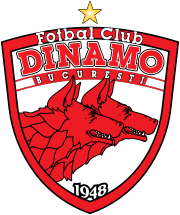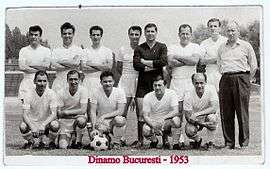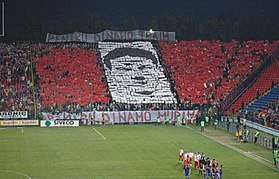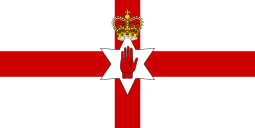FC Dinamo București
Fotbal Club Dinamo București (Romanian pronunciation: [diˈnamo bukuˈreʃtʲ]), commonly known as Dinamo București or simply Dinamo, is a Romanian professional football club based in Bucharest.
 | ||||
| Full name | Fotbal Club Dinamo București | |||
|---|---|---|---|---|
| Nickname(s) |
| |||
| Short name | Dinamo | |||
| Founded | 14 May 1948 | |||
| Ground | Dinamo | |||
| Capacity | 15,032 | |||
| Owner | Ionuț Negoiță (71.94%) DDB Supporters Association (20.06%) Others (8%) | |||
| General Manager | Vacant | |||
| Head Coach | Adrian Mihalcea | |||
| League | Liga I | |||
| 2018–19 | Liga I, 9th | |||
| Website | Club website | |||
|
| ||||
| Active departments of CS Dinamo București | ||
|---|---|---|
| Football | Men's Handball | Women's Handball |
| Hockey | Basketball | Water polo |
| Men's Volleyball | Women's Volleyball | Rugby |
| Martial arts | Athletics | Boxing |
| Kayak | Canoe | Cycling |
| Gymnastics | Weightlifting | Judo |
| Modern Karate | Wrestling | Swimming |
| Fencing | Shooting | Taekwondo |
| Tennis | Chess | Skiing |
Founded in 1948, they have spent their entire history in Romania's top tier, the Liga I. Domestically, Dinamo București is one of the two most successful teams in the country, having won 18 Liga I, 13 Cupa României, two Supercupa României, and one Cupa Ligii. In the 1983–84 season, they became the first Romanian club to reach the semi-finals of the European Cup.[1]
Dinamo's traditional home colours are white and red, while the current crest is a modified version of the one adopted in the 1998. Their home venue is Stadionul Dinamo, although significant matches are also played at Arena Națională. Their bitter rivals are neighbouring FCSB, with the match between the two being commonly referred to as "the Eternal Derby".
History
Dinamo București was founded on 14 May 1948, when Unirea Tricolor MAI, newly entered in January 1948 under the umbrella of the Communist regime's Internal Affairs Ministry, merged with Ciocanul București. The sporting club represented the above-mentioned institution.[2] The "Dinamo" name was used for the very first time on 1 May 1948. Nevertheless, the real debut of Dinamo was in the 1947-48 Divizia A edition, finishing eighth. The squad included Ambru, Angelo Niculescu, Teodorescu, Șiclovan, Bartha, and Sârbu. In 1955, Dinamo achieved its inaugural league championship. With Angelo Niculescu as head coach, Dinamo had a strong offensive power, with an attack formed by Ene I, Neaga and Suru. The defense, with players like Băcuț I, Băcuț II, Szökő, Călinoiu, was the best in the championship, with only 19 goals conceded.[3]
In the fall of 1956, the team achieved Romania's inaugural presence in European competition in the European Champion Clubs' Cup, created in 1955. On 26 August 1956, with 32,000 spectators, Dinamo defeated Galatasaray, 3–1. In the second leg, Dinamo would lose in Istanbul 1–2.
Other teams Dinamo would compete in Europe, were Real Madrid (a team with Di Stefano and Gento – the game played in Bucharest took place at 23 August Stadium, and established a new record for this arena: 100,000 spectators[4]), Inter Milan and Feyenoord: 0–3 and 0–2.
In 1973, Dinamo won a European Cup home match against Northern Ireland's Crusaders Belfast with 11–0. The game continues to be the largest margin of victory in the history of the European Cup.
The autumn of 1983–84 was going to represent a valuable step into the international arena. The "European Champions Cup campaign" started with Finnish team Kuusysi Lahti, which they defeated 1–0 and 3–0. The second round pushed Dinamo against the current champion, Hamburger SV – team of Stein, Kalz and Magath. At Bucharest, Augustin, Mulțescu and Orac scored for 3–0.[5][6] The thrilling second leg finished 3–2, with goals from Țălnar and Mulțescu). In order to accede to the semi-finals of CCE, Dinamo had to defeat another top team—Dinamo Minsk. The first leg was 1–1, Rednic equalizing in the 87th minute, and it was followed by a 1–0 victory at Bucharest with Augustin scoring. Dinamo was the first Romanian team to reach the European Champions Cup semi-finals,[7] where it met Liverpool. Dinamo lost 1–0 at Anfield and 2–1 in Bucharest, as Liverpool progressed to the 1984 European Cup Final.[8]
In 1986 Dinamo won the Cup against Steaua, the team that only a few days before won the European Cup final.

In the summer of 1990, Dinamo—with Mircea Lucescu as coach—conquered a new national title, its thirteenth. Also the team won the Cup final 6–4, against Steaua.
Dinamo won the league title in 1992, 2000, 2002, 2004, and 2007, but failed to reach the final phases of European competitions during those years.
In 2013, the team changed ownership, as businessman Ionuț Negoiță bought the club.[9] Instead, the club was declared insolvent and started a period of poor results. Even after the club got out of insolvency, the results didn't improve and Dinamo failed to qualify for the Liga I championship play-off for two seasons in a row (2017–18 and 2018–19).
Crest and colours
Dinamo's colours are red and white. The current crest includes the profile of two red dogs and also a gold star above them, representing the club's tenth league title.
Stadium
.jpg)
Dinamo plays its home games at Stadionul Dinamo. The arena was built in 1951, and for the official inauguration Dinamo played a game against Locomotiva Timișoara. The stadium capacity was planned at 16,000, but the installation of seats decreased it to 15,032. The stadium is part of a larger complex which contains a smaller stadium, Stadionul Florea Dumitrache, where the second team, Dinamo II, would play its matches. It is currently used by CS Dinamo București rugby team. There is also a sports hall and a swimming pool.
The stadium is referred to as "Groapa" (The Pit), as it was dug rather than raising stands. The North stand is honors Peluza Cătălin Hîldan, a former Dinamo player who died in 2000 at the age of 24.
Dinamo plays significant matches, such as against rivals Steaua, at Arena Națională.
Support
Dinamo has an estimated 13% support in Romania, making them the second most supported Romanian club, after FCSB/Steaua.[10] The largest concentration of fans is in Bucharest, mainly in the northeast and central areas of the city. The club also has important fan bases on other parts of the country and where significant bases of Romanians are found.

The roots of the Dinamo ultras (fans) movement can be found in 1995 when groups like Dracula and Rams Pantelimon appeared in the North End. In 1996 a group called Nuova Guardia was formed, and became the leading group in the stadium and later on in the entire Romanian ultras movement.[11] Following the death of the former captain, Cătălin Hîldan, in 2000, the fans renamed the North End of Dinamo's stadium to Peluza Catalin Hîldan (PCH Stand) in his honor. The majority of supporters are located in the PCH, but several factions have moved to the South End.
Rivalries & Friendships
Dinamo's significant rivalry is with FCSB, with matches between them dubbed the Eternal derby. Both clubs have had the most popularity in Romania with as strong reactions from its respective fans in clashes in the stadium during games and elsewhere. In 1997, Dinamo's fans set a sector of the Stadionul Ghencea on fire.[12] On 16 August 2016, during FCSB's UEFA Champions League 0–5 play-off loss against Manchester City, Dinamo fans unveiled a banner that read Doar Dinamo București ("Only Dinamo Bucharest")
The club's second most important rivalry is against Rapid București. In the 1990s, there was fierce competition between the two in winning the championship title.
Another rivalry is held against Universitatea Craiova; both finished with the same number of points in the 1972–73 Divizia A, but Dinamo was given the title because of their superior goal difference. A conflict has existed ever since.[13][14] Other smaller rivalries exist, such as the one against Petrolul Ploiești.
Dinamo's fans have a good friendship with Universitatea Cluj's fans. The friendship started in the mid-1990s, both ultras groups being linked with "the mentality, fanaticism and nationalist side"[15] and the common hate for Steaua.
Youth program
Dinamo has an important infrastructure for training professionalism in the sport and developing interest in the youth area. The youth center organises a system based on nine age groups between nine and 18 years. Dinamo has around 180 juniors.
All the groups play in the competitions organised by the Bucharest Football Association and in those created by the Romanian Federation. Youths around 16–18 years old are promoted to the second team, Dinamo II.
The youth center has its base in the Dinamo Sports Center, where they have eight dressing rooms for the players, one for the coaches, one for the referees, a medical center and a store room for the equipment. Also, the center has many training grounds, among them the Piți Varga field.[16]
Honours
Domestic
Leagues
- Liga I
- Winners (18): 1955, 1961–62, 1962–63, 1963–64, 1964–65, 1970–71, 1972–73, 1974–75, 1976–77, 1981–82, 1982–83, 1983–84, 1989–90, 1991–92, 1999–2000, 2001–02, 2003–04, 2006–07
- Runners-up (20): 1951, 1952, 1953, 1956, 1958–59, 1960–61, 1966–67, 1968–69, 1973–74, 1975–76, 1978–79, 1980–81, 1984–85, 1986–87, 1987–88, 1988–89, 1992–93, 1998–99, 2000–01, 2004–05
Cups
- Cupa României
- Supercupa României
- Cupa Ligii
- Winners (1): 2016–17
Players
Current squad
- As of 15 March 2020[20]
Note: Flags indicate national team as defined under FIFA eligibility rules. Players may hold more than one non-FIFA nationality.
|
|
Out on loan
Note: Flags indicate national team as defined under FIFA eligibility rules. Players may hold more than one non-FIFA nationality.
|
|
Retired numbers
Note: Flags indicate national team as defined under FIFA eligibility rules. Players may hold more than one non-FIFA nationality.
|
|
Club officials
Board of directors
|
Current technical staff
|
Statistics and records
European cups all-time statistics
As of August 3, 2017.
| Competition | S | P | W | D | L | GF | GA | GD |
|---|---|---|---|---|---|---|---|---|
| UEFA Champions League / European Cup | 18 | 66 | 24 | 10 | 32 | 96 | 106 | – 10 |
| UEFA Cup Winners' Cup / European Cup Winners' Cup | 5 | 20 | 8 | 4 | 8 | 25 | 18 | + 7 |
| UEFA Europa League / UEFA Cup | 23 | 90 | 37 | 14 | 39 | 147 | 127 | + 20 |
| UEFA Intertoto Cup | 1 | 4 | 1 | 0 | 3 | 4 | 6 | – 2 |
| Total | 47 | 180 | 70 | 28 | 82 | 272 | 257 | + 15 |
Records in the league:
- Consecutive winning games: 17 games (12 June 1988 – 27 November 1988)
- Best unbeaten run: 47 games (26 May 1991 – 20 September 1992)
- Player with most appearances:

- Top scorer:

- Player with most appearances in international games:

- Top scorer in international games:

Records in the European competition:
- Biggest home win: Dinamo 11–0

- Biggest away win:

- Heaviest home defeat: Dinamo 0–3


- Heaviest away defeat:

Notable former players
The footballers enlisted below have had international cap(s) for their respective countries at junior and/or senior level and/or more than 100 caps for FC Dinamo București.
Notable former managers
Notes
- Since Unicul Căpitan (The Only Captain) died, no player will wear the number 11 shirt at Dinamo București, since the club decided to retire the shirt out of respect and posthumous honor for legend Cătălin Hîldan.
- Patrick Ekeng died at Floreasca Hospital after he had gone into a coma in a match on 6 May 2016 against Viitorul Constanța where he joined as a substitute.
- He joined Dinamo București's Hall of Fame back in 2013, after scoring 213 goals in 513 games for Dinamo București, hence the club decided to retire his number.
References
- the first Romanian club
- Dinamo (2009). "O POVESTE MEREU FRUMOASA" (in Romanian). fcdinamo.ro.
- Fun Club Dinamo (2009). "Campionat 1955" (in Romanian). fanclubdinamo.freeservers.com.
- Lucian Ionescu (2007). "Istorie stadion Național" (in Romanian). sportm.ro. Archived from the original on 14 November 2012.
- fcdinamo.ro (2008). "VIDEO / Dinamo – Hamburg 3 – 0" (in Romanian). fcdinamo.ro.
- mysport.ro (2008). "Mai buni decît cei mai buni!" (in Romanian). dinamovisti.mysport.ro. Archived from the original on 22 October 2009.
- fcdinamo.ro (2008). "Prima echipă românească în semi-finalele CCE" (in Romanian). fcdinamo.ro.
- "Dinamo București 1 - 2 Liverpool". UEFA. Retrieved 25 April 2020.
- "Ionuț Negoiță este noul ACȚIONAR MAJORITAR de la DINAMO!". Archived from the original on 5 July 2013. Retrieved 14 March 2013.
- Centrul de Studii si Cercetari Infopolitic (2016). "Studiu: 49% dintre români ţin cu Steaua. Câți au optat pentru Dinamo sau Astra" (in Romanian). www.dolce-sport.ro.
- A.G.M.Dinamo (2009). "La multi ani Nuova Guardia" (in Romanian). agmdinamo48.blogspot.com.
- Ziare.com (2009). "Dinamovistii sarbatoresc 12 ani de la incendierea peluzei din Ghencea" (in Romanian). ziare.com.
- "CRAIOVA-DINAMO. Titlul pierdut dubios în '73 a generat ura oltenilor" [CRAIOVA-DINAMO. The title lost in a strange way in '73 generated the hate of "the People of Oltenia"] (in Romanian). Fanatik.ro. 22 April 2017. Retrieved 29 April 2018.
- "CS U Craiova – Dinamo, orgoliul a rămas, obiectivele s-au schimbat" [CS U Craiova – Dinamo, the pride remains, the objectives have changed] (in Romanian). Telekom Sport. 16 September 2017. Retrieved 29 April 2018.
- https://www.numaiu.ro/articole/fratia-cu-dinamo-povestea-care-uneste-si-dezbina-deopotriva
- fcdinamo.ro. "CENTRUL DE COPII SI JUNIORI. Viitorul fotbalului dinamovist" (in Romanian). fcdinamo.ro.
- Steaua gave up the trophy in 1990.
- http://www.dolce-sport.ro/fotbal/fotbal-intern/steaua-dinamo-1988-cupa-mircea-lucescu-anghel-iordanescu-44101/
- The goal of Gabi Balint was canceled because of an offside, signalled by assistant referee George Ionescu. Steaua retired from the field (by command of Valentin Ceaușescu, son of president Nicolae Ceaușescu) but the Romanian Football Federation offered the Cup to Steaua București. In 1990, Steaua renounced this trophy because it was won unjustly.
- "Echipă" [Squad] (in Romanian). FC Dinamo București. Retrieved 4 September 2019.